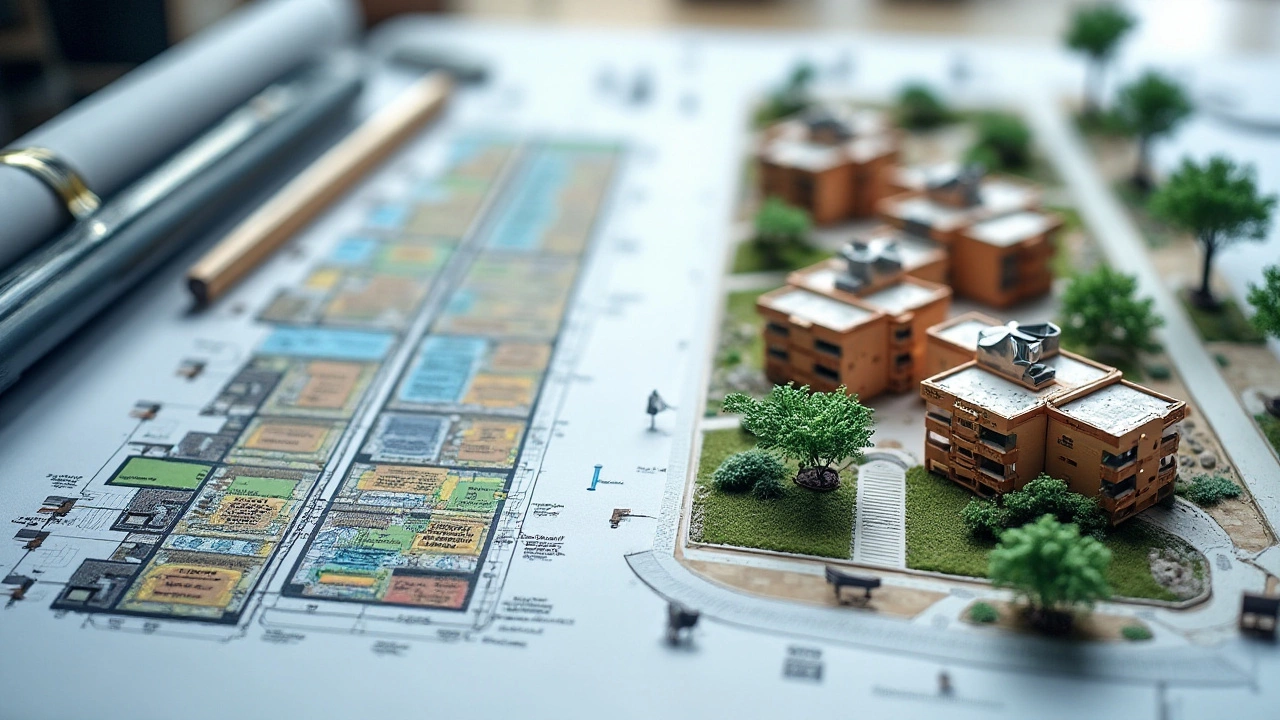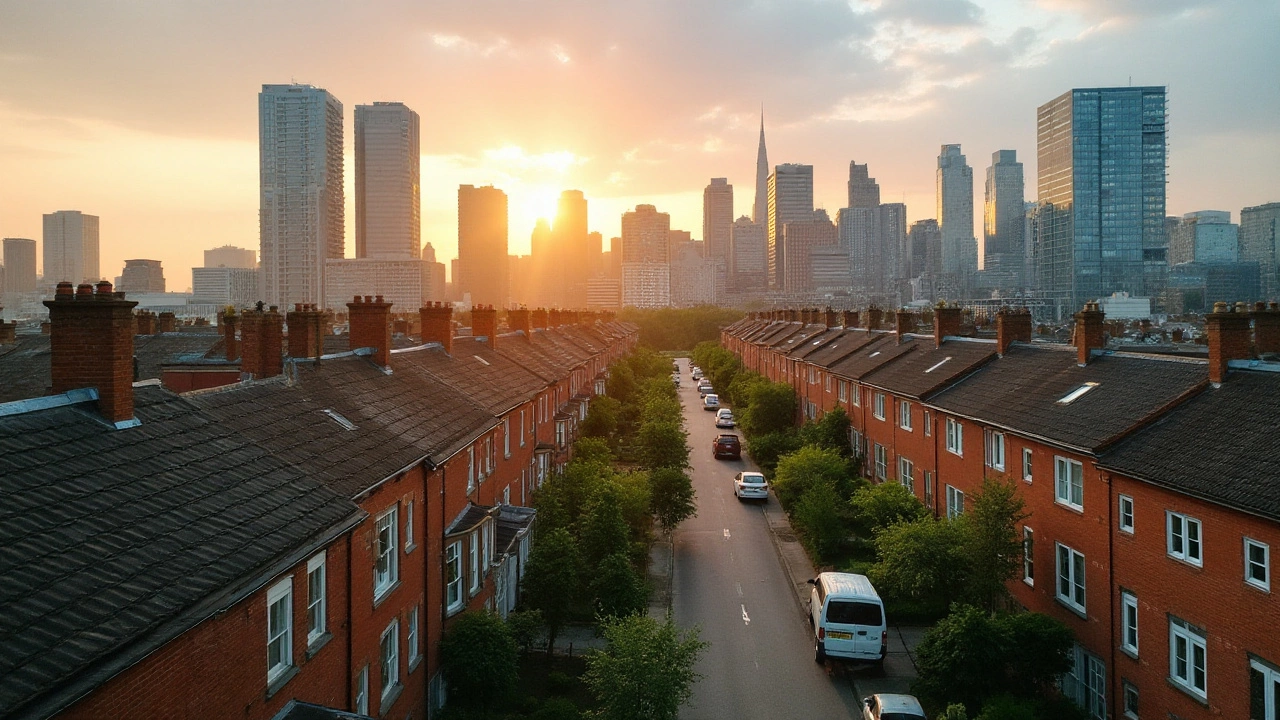When it comes to construction, the difference between commercial and residential buildings goes beyond mere appearance. While both serve essential purposes in our modern landscapes, each type carries unique characteristics that cater to distinct needs. Deciphering these differences is vital for anyone involved in construction, from developers to investors, as it influences design choices, compliance requirements, and financial strategies.
Commercial buildings are primarily constructed for business purposes. They host offices, retail spaces, factories, and more, each with specific spatial and infrastructural needs. Meanwhile, residential buildings serve as homes and living spaces for individuals and families, requiring an entirely different approach to layout and amenities.
Diving into the world of these building types reveals crucial insights into how they shape our cities and communities, and how their distinct features impact those who plan, design, and finance these structures.
- Understanding Commercial Buildings
- Exploring Residential Buildings
- Structural Design Variations
- Regulatory and Compliance Factors
- Intended Purpose and Usage
- Investment and Market Considerations
Understanding Commercial Buildings
Commercial buildings stand as the backbone of our business ecosystem, meticulously designed to support a myriad of entrepreneurial activities. These structures are impressive not just in scale, but in the diversity of their functions too. From towering skyscrapers that host global headquarters to expansive shopping malls filled with retail outlets, each commercial space is crafted with efficiency and purpose in mind. The architecture of a commercial building often prioritizes adaptability, allowing spaces to be reconfigured to accommodate changing needs, such as fluctuating employee numbers or evolving retail trends. This flexibility is critical in a volatile economic climate, ensuring that businesses can pivot swiftly without the physical constraints of their environment holding them back.
A crucial aspect that distinguishes commercial properties is the regulatory framework that they must adhere to. Building codes for commercial structures are often more stringent compared to residential requirements. These regulations ensure the safety and accessibility of spaces that host large populations or serve crucial functions. For example, compliance with the Americans with Disabilities Act (ADA) is mandatory, which dictates specific design elements like ramps and elevators. Moreover, commercial buildings must often meet more rigorous fire safety standards, incorporate robust security systems, and provide ample parking spaces to support the high foot traffic typical in business areas.
The economic implications surrounding commercial construction are significant. The value of a commercial property is closely tied to its location, tenant mix, and lease length, which makes investment in commercial real estate a highly analytical endeavor. Investors and developers rely heavily on data-driven insights to select viable sites and to determine the type of commercial entities that would thrive there. As urban centers continue to evolve, commercial buildings play an instrumental role in shaping the business landscape, often becoming landmarks that influence local economies. As architect Norman Foster once said, "We are increasingly asked to identify projects that add value to communities – these are the places where businesses want to be."
"Architecture is about trying to make the world a little bit better for living in," Norman Foster.This focus on community value can be seen in the rise of mixed-use developments, which blend commercial spaces with residential and recreational areas to create vibrant, self-sustaining neighborhoods.
Commercial construction is also deeply intertwined with advancements in technology. The integration of smart building systems allows for enhanced energy efficiency and sustainability – features that are becoming non-negotiable in the pursuit of green building certifications like LEED. These technologies not only reduce operational costs but also create environments that promote productivity and well-being. The Internet of Things (IoT) is revolutionizing how these buildings operate, from intelligent lighting systems that adapt to natural daylight to HVAC systems that adjust based on real-time occupancy data. Embracing such innovations ensures that commercial properties remain competitive in a rapidly advancing world.
These multifaceted structures are crucial cogs in the economy, supporting jobs and driving innovation. Their sheer variety means they can accommodate everything from logistics hubs that facilitate global trade to hotels that cater to international travelers. The construction and design of these buildings require a keen understanding of both architectural integrity and economic strategy, balancing creativity with commercial acumen. For anyone looking to venture into the realm of commercial construction, it is essential to grasp the intricacies of these mighty edifices, for they are not just buildings, but catalysts of commerce and culture, shaping the way we interact with the world around us.
Exploring Residential Buildings
Residential buildings form the very fabric of our daily lives, providing spaces where we live, grow, and create memories. From towering apartment complexes in bustling urban centers to sprawling suburban homes with manicured lawns, these structures are designed with personal comfort and community living in mind. The construction of residential buildings prioritizes factors such as privacy, safety, and the aesthetic appeal that resonates with occupants' lifestyles. Unlike commercial construction, which may lean towards durability and functionality suitable for high traffic and usage, residential structures focus on creating homely environments.
One of the fundamental aspects of residential architecture is versatility. Homes should adapt to different family sizes and dynamics. For example, open floor plans have gained popularity as they foster a sense of connection, allowing for fluid movement and shared spaces. Yet, private and designated areas remain crucial, providing sanctuaries within a home. Such designs require careful consideration of acoustics and natural light to enhance the ambiance.
Regulations and codes for residential buildings can be stringent, aiming to ensure safety and comfort. These rules often dictate elements like fire safety measures, egress points, and even environmental factors like energy efficiency and sustainable materials. In recent years, there's been a significant shift towards incorporating eco-friendly practices in residential construction. Solar panels, rainwater harvesting systems, and thermal insulation are becoming standard inclusions. As per a recent study published in the Journal of Green Building, homes built with sustainable materials can reduce future energy costs by up to 30%.
"The home should be the treasure chest of living," said Le Corbusier, a pioneer in modern architecture, emphasizing the importance of designing residential spaces as havens for individuals and families.
Another essential element in residential buildings is the inclusion of recreational amenities. In apartment buildings, it's common to see shared facilities such as pools, gyms, and clubhouses. These amenities enhance the living experience by providing spaces for relaxation and social interaction. In contrast, single-family homes might invest in landscaped gardens or media rooms to serve similar purposes.
Residential buildings not only fulfill practical needs but also contribute to a community's cultural and social dimensions. The architectural style of homes can reflect local traditions, historical influences, and the individual expressions of the inhabitants. From Victorian-era constructions to modern minimalist structures, residential architecture is a potent medium for storytelling, shaping how we perceive and interact with our surroundings. As we continue to evolve in our living spaces, the future of residential construction promises innovation, comfort, and a deeper integration with our natural environment.

Structural Design Variations
Structural design plays a pivotal role in the functionality and safety of buildings, distinguishing commercial construction from residential buildings in multiple ways. The design of a commercial structure often centers around maximizing space utility for its intended business function. This generally involves open layouts for flexibility and adaptability, accommodating everything from offices to retail floors. For instance, high-rise commercial buildings usually incorporate steel-framed constructions due to their strength and ability to support taller structures. By contrast, residential constructions frequently prioritize aesthetics and personal comfort, often utilizing wood or brick materials to achieve a warm and inviting atmosphere.
One can also see significant differences in the architectural style and attention to detail between the two types of buildings. A commercial building is typically designed with a focus on function over form, ensuring durability and practical use. The architectural trend leans towards modern, sleek surfaces with glazing and steel as common elements. Residential buildings tend to include more ornamental features, as the design is influenced by homeowner preferences, leading to variations in everything from windows to roofing styles. This difference highlights the importance of understanding client needs and the ultimate purpose of the structure during the design phase.
Load-Bearing and Safety Standards
Additionally, building codes and safety standards vary widely between commercial and residential properties. Commercial buildings adhere to stricter codes due to higher occupancy levels and diverse utility demands. These include elaborate HVAC systems, electrical setups, and fire safety measures, demanding robust design considerations. Residential buildings, while also subject to safety regulations, often focus more on energy efficiency and personal safety features, which might include the capacity for smart home integration.
According to renowned architect Frank Lloyd Wright, "A building should appear to grow easily from its site and be shaped to harmonize with its surroundings if Nature is manifest there."
Material Selection and Durability
The materials used in commercial construction often cater to durability and long-term maintenance, engineered to withstand both frequent use and environmental factors. Commercial developers may opt for materials such as reinforced concrete or advanced composites that assure longevity and structural integrity. In contrast, residential designers frequently select materials based upon comfort, personalization, and cost-effectiveness; materials such as wood offer a natural aesthetic, although less durable, they're often used for their affordability and ease of customization. With effective material selection, both building types strive for an optimal balance between functionality and sustainability.
| Type of Building | Primary Materials | Design Focus |
|---|---|---|
| Commercial | Steel, Concrete, Glass | Durability, Functionality |
| Residential | Wood, Brick, Vinyl | Aesthetics, Comfort |
The structural design differences between commercial and residential buildings reflect their distinct requirements and the environments they are meant to enhance. While both aim to provide utility and safety, the means by which they achieve these goals underline the innovation and specific engineering that makes each unique. Recognizing these differences is not only crucial for builders and architects but for anyone who occupies these spaces, highlighting how tailored environments shape daily experiences and business activities.
Regulatory and Compliance Factors
When embarking on a construction project, understanding the regulatory and compliance factors that differentiate commercial construction from residential buildings is vital. Every city and country establishes rules to ensure safety, accessibility, and sustainability in building design. For commercial buildings, these regulations can be exhaustive, given the nature of the activities they are intended to host. For instance, fire safety protocols are generally more stringent in commercial spaces where many individuals gather simultaneously, like in office complexes or shopping malls. There's a myriad of regulations regarding emergency exits, fire-resistant materials, and sprinkler systems that developers must adhere to, ensuring safety and compliance with governing standards.
In contrast, residential buildings primarily need to comply with safety guidelines that ensure the wellbeing of occupants. While building codes dictate the structural integrity and electrical systems within homes, they may not be as complex as those for commercial counterparts. However, residential areas have unique compliance considerations such as zoning laws, which control the development and size of homes within certain districts. Additionally, regulations regarding energy efficiency are becoming increasingly relevant, with many jurisdictions pushing for greener construction practices to reduce carbon footprints.
As noted by the National Association of Home Builders, 'Properly navigating compliance and regulation for residential projects ensures safer, more sustainable living environments.'
Developers must be keenly aware of the legal distinctions that define project scopes and ensure compliance from inception to completion. Regulatory bodies often enforce these standards through regular inspections and certifications. Notably, ignoring these regulations isn't just a matter of legal penalties; it can also result in costly delays and structural modifications. For commercial projects, additional oversight may include adherence to the Americans with Disabilities Act (ADA), guaranteeing that facilities are accessible to everyone, which necessitates keen attention to detail in design and layout.
An equally important consideration is the environmental regulations that affect building practices. Green building standards, such as LEED certifications, are increasingly sought after in both commercial and residential projects, impacting marketability and long-term savings. Compliance with these standards not only aids in reducing a building's ecological impact but also improves the indoor environment for occupants. It is becoming commonplace for regulatory factors to shape investment decisions as potential returns can be influenced by a building’s energy efficiency and environmental compliance.
For businesses eyeing construction investment, understanding these compliance factors is essential. Not only do they influence the initial costs and timelines, but they also govern the building’s operational capabilities post-construction. This is especially critical in urban projects where compliance across multiple phases requires meticulous planning and agile management. Thus, the distinct regulatory and compliance factors that govern commercial and residential buildings are key drivers in shaping the infrastructure of our communities.

Intended Purpose and Usage
Understanding the intended purpose and usage of a building is fundamental to its design and function. In the world of commercial construction, buildings are tailored to the specific needs of businesses, which can be as varied as the companies that occupy them. From towering office skyscrapers to sprawling shopping complexes, every commercial building serves a distinct purpose. Developers aim to match the architectural and structural elements with the functional demands of businesses, including considerations for foot traffic, employee workspace, or customer interaction. These aspects dictate layouts, flow, and even the technology integrated within the building. In contrast, residential buildings are designed with living in mind. They provide sheltered spaces where individuals and families establish their daily routines and personal sanctuaries. Hence, elements like privacy, comfort, and safety take precedence. Each type of construction must consider distinct aspects due to their separate end goals.
Commercial spaces often require expansive interiors without support beams interrupting the flow, utilizing steel frames and reinforced concrete to achieve long, uninterrupted spans. This structural need contrasts with residential buildings, where load-bearing walls are common. Moreover, energy efficiency and sustainability have become paramount in both sectors. However, while residential developers might focus on using eco-friendly materials to enhance living quality and reduce utility bills, commercial developers target cost-reduction strategies that encompass waste management and energy usage across larger scales. A fascinating fact from the Building Owners and Managers Association (BOMA) indicates that commercial buildings in the U.S. alone have shifted to integrate renewable resources, aiming for a 50% reduction in energy consumption by 2030.
The range in purposes extends to infrastructural needs such as parking, where a commercial building might necessitate a vast parking structure or provide proximity to public transport nodes, residential buildings are often nestled in communities with limited parking that favors personal vehicle storage. The International Building Code (IBC) stipulates varying requirements for each, further guiding architects and engineers. For instance, commercial code considerations may include accommodating large crowds leading to numerous exits, enhanced fire suppression systems, and compliance with accessibility regulations, all of which differ dramatically from those required in residential settings.
"The whole world is rapidly moving towards urbanization, creating immense opportunities for enhancing spaces where we work and live." - Kofi Annan
The investment and financial strategies tied to each type also mark a stark contrast. With commercial construction, returns on investment are often gauged through profitability metrics, such as rental yields or property appreciation, alongside tax incentives. Residential investments, however, might lean more towards long-term stability and value retention. This intricate dance between purpose and utility underscores the importance of understanding the nuances involved in each building type, as they shape the environment we interact with daily.
Investment and Market Considerations
When considering investments in the realm of commercial construction versus residential buildings, the distinctions are both nuanced and profound. The type of building impacts market dynamics, return on investment, and risk factors. Investors typically eye commercial properties for their potential high returns driven by rental yields from businesses that tend to agree to long-term leases. These long tenures provide financial stability and predictability, but on the flip side, they come with higher initial costs and risks related to prolonged vacancy during economic downturns.
Residential investments, while often yielding lower per-unit returns, benefit from the steady demand for housing. Homes are generally more straightforward to maintain and easier to finance thanks to a myriad of loan options available to potential buyers, further stabilized by constant residential demand. Navigating the investment waters requires a balanced understanding of market trends. For instance, urban areas often present better commercial opportunities, fueled by an increased presence of enterprises and working professionals, who subsequently drive the need for housing closer to workspaces.
"The best investment on Earth is earth," says renowned American real estate investor Louis Glickman, emphasizing the timeless allure of property investment.
Interestingly, recent statistics highlight shifting trends where sustainable and mixed-use developments are becoming popular, blending commercial and residential spaces to maximize land use efficiency. According to the National Association of Realtors, mixed-use properties not only help diversify income streams but also increase property value by up to 12% more than traditional single-use developments. This trend vividly illustrates how the lines between commercial and residential investments are gradually converging, nudging investors to adopt more multifaceted strategies.
As every investor's strategy differs, relying on sound market research cannot be overemphasized. Commercial construction demands an acute understanding of business cycles and urban growth patterns, whereas residential buildings investments ask for insights into demographic shifts and local housing policies. Utilizing advisory services from real estate analysts, staying informed through platforms like RealtyTrac, or engaging financial consultants can significantly enhance decision-making processes in this versatile landscape. As sustainable development gains momentum, new investment opportunities arise, urging a closer inspection of options that align with both economic returns and environmental stewardship.
